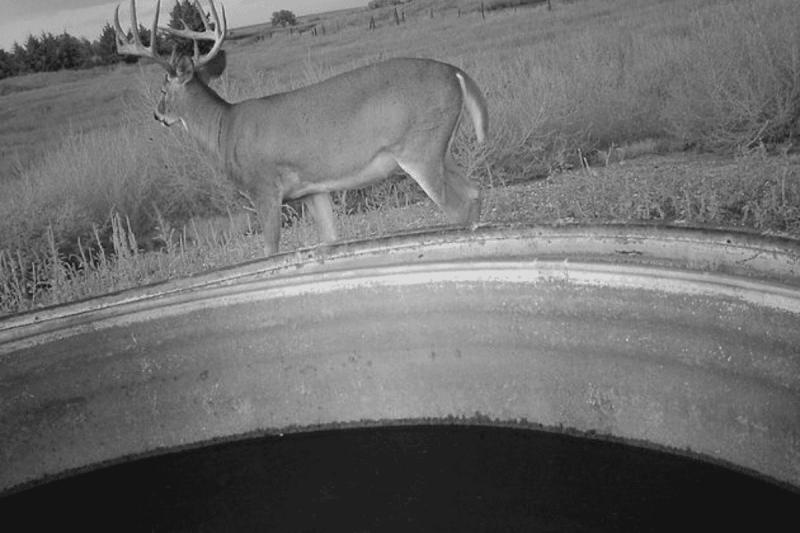The Hidden Downsides of Using Trail Cameras in Hunting

Although it was mid-August, the anticipation felt more like Christmas morning. Armed with a pair of SD cards, a bag of D batteries, and a leather Bota filled with water, I headed to the field for my very first trail camera card retrieval. The suspense grew almost unbearable as I approached the camera by the open gate. Just a week earlier, I had positioned it there after noticing that deer were frequently browsing in the nearby bean field and using the open gate as their main path to access it. Upon my return, the camera was dead, but the card was full—an indication that something had been captured! My suspense quickly shifted to eager anticipation as I hurried back to the family desktop to review the card's contents. The wait wouldn't last long.
One of the first images I opened was of a stunning 150” 9-point buck, fully velveted and heading straight for the lush forage. That autumn, I spent almost every weekend sitting near that same open gate. However, as the season concluded, I never once laid eyes on that big 9-pointer. I had fallen victim to what I now call "Trail Camera Vision Constriction," a kind of tunnel vision that only a trail camera—and a big buck—can create. It was a mistake I vowed never to repeat.
That incident occurred nearly 15 seasons ago. Since then, my collection of trail cameras has expanded, as has my understanding of how to use them effectively. Because, ultimately, they are just tools—tools in a larger toolkit. Unfortunately, many of us hunters tend to rely on trail cameras as though they were the only tool available for scouting. Others argue that these cameras detract from the original skills of hunting, such as woodsmanship. In this article, I will discuss five ways that trail cameras might be hurting your hunt.
Intrusion
Undoubtedly, intrusion on your hunting grounds is the primary reason why trail cameras can negatively impact your hunt. Each time you visit the property to check the camera cards, you leave a trace behind. The deer are fully capable of detecting the human scent you've left, especially when it comes to mature deer. These experienced animals are scouting you just as diligently as you are scouting them. Repeatedly checking a trail camera placed in a buck's home range will eventually drive him away, forcing him to relocate.
Cellular trail cameras excel in these situations. Before their introduction, difficult-to-reach areas with cameras were often monitored too frequently, which would push the deer into retreat. Once the area was burned out, you would be left puzzled, wondering where all the deer had gone. Now, with a cellular camera, you can place it and allow it to collect data continuously. Meanwhile, you receive updates instantly on your phone. Problem solved, right? Unfortunately, no. There are still other important factors to consider.
False Hope
Whether you use traditional trail cameras or cellular ones, both come with their advantages and drawbacks. Since this article focuses on the negative impacts of trail cameras on your hunting, let’s explore another way they can hurt your success. Many of us have experienced this. Day after day, and week after week, a large buck consistently appears on your camera between 8 p.m. and 3 a.m. His image becomes ingrained in your mind, and you cling to the hope that he will break his nocturnal pattern while you wait in a nearby stand. Yet, disappointment follows when you hear that a neighbor, half a mile away, has harvested the same buck.
Despite their usefulness, trail cameras can be equally harmful. They often provide us with a misleading sense of optimism, primarily because we regularly see pictures of a big buck in the area. Even if those pictures are taken seven hours after legal shooting hours. Most of the time, true success requires more effort—getting out into the field, tracking the buck’s movements, and determining where he travels during daylight hours.
No Hope
At times, trail camera data can have the opposite effect, leaving you feeling hopeless. How often have you set up cameras on a property, only to end up with images that resemble a junior high school yearbook? A card full of does and young bucks rarely inspires much optimism. You may eventually dismiss the spot as a waste and move on to what seems like better locations. But then, as luck would have it, in the second week of November, you get a picture of the giant buck you've been chasing. Suddenly, you regret not being in a nearby tree stand when it mattered most.
Just because your camera isn’t capturing a shooter doesn’t mean one isn’t nearby. Keep in mind that a trail camera only covers an area measured in feet, while the actual space it monitors spans acres. Trust the fresh signs and your instincts in these scenarios. If your camera shows a lot of does, a buck is bound to find them eventually.
Tunnel Vision
This issue is what I previously referred to as "Trail Camera Vision Constriction." Tunnel vision is another way trail cameras can negatively affect your hunt. In an era focused on hit lists and targeting mature bucks, it’s easy to become fixated on pursuing a specific trophy. Unfortunately, once you’re wearing those blinders, they can be difficult to remove. Before you realize it, the season ends, and you feel as if you’ve spent the entire time chasing a ghost. In hindsight, if you had shifted your focus earlier, you might have tagged another worthy buck.
Reflecting on the story I shared at the beginning of this article, had I hunted and scouted as I used to, without relying so heavily on trail camera images, I likely would have had a chance at a buck that fall. Instead, I ended the season with an unfilled tag, all because I trusted a summer’s worth of photos from my first trail camera. If your goal for the season is to harvest a specific buck, that’s great. But for many hunters, myself included, it’s easy to get wrapped up in trail camera data on one deer and miss out on other prime opportunities.
The Demise of Imagination
The most personal reason I believe 4g trail cameras are harming your hunt lies in their ability to stifle imagination. When I was young, the one thing that captivated me most about hunting was the element of the "unknown." How large was the buck that scraped along the logging road? How many points did the buck have that crossed the creek? What strange creature could possibly rub against a telephone pole? Every single sit felt like it would be my chance to encounter the legendary 30-point buck. As I stared at an image of The Beatty Buck on my Primos Can Call, nestled in a wooden tree stand, my mind played out the scene repeatedly.
There was no need for a cell phone to fill my time. My mind, from start to finish, worked like an episode from the Outdoor Channel. Though I never did get my shot at the 30-point buck, it was the mystery and anticipation that kept me coming back for more. Now, I sit with years of photos of specific bucks. I know where they live, what food sources they prefer, and what scrapes they frequent. I even know their ages and have named many of them. While I appreciate this new era of hunting technology, I can't help but miss those simpler days. Days when my imagination ran wild with every track and rub I discovered.
In the end, modern trail cameras have undoubtedly helped hunters nationwide, myself included, fill their tags. But have they truly made us better hunters overall? Or are they doing more harm than good? This is a debate as fierce as Fixed Blade vs. Expandable Broadheads, Compounds vs. Crossbows, or Tree Stands vs. Saddles. Ultimately, what matters most is what excites you about being outdoors, bow in hand, and tag in pocket. That is, after all, the heart of the journey. Happy hunting!
Post Your Ad Here



Comments